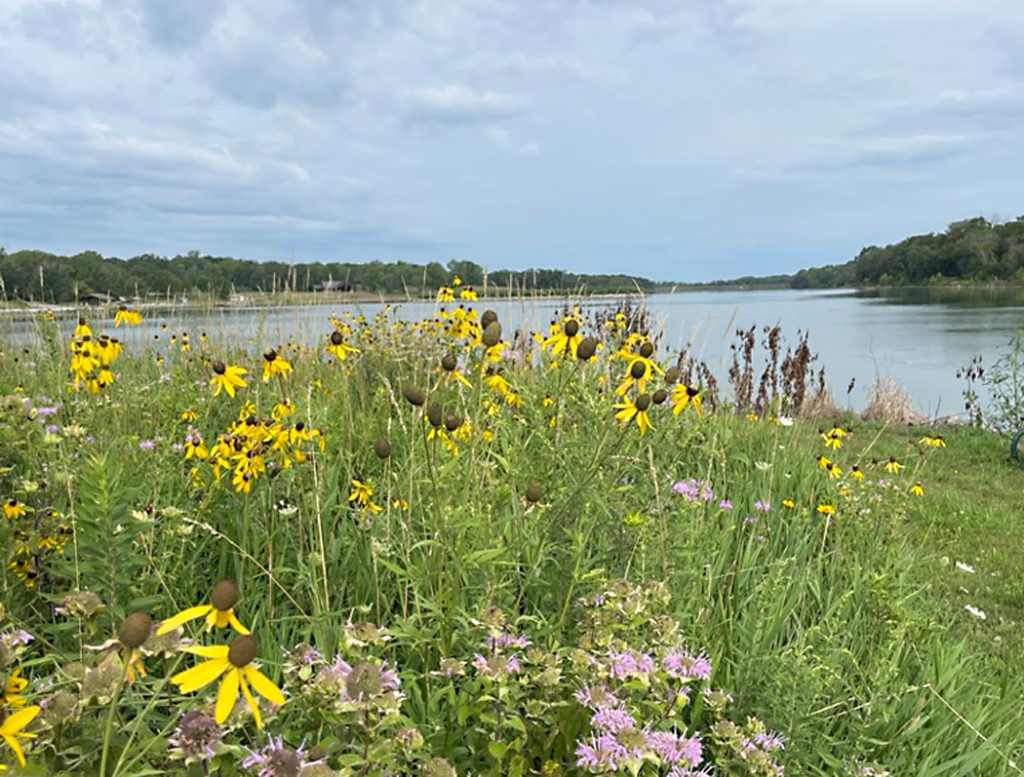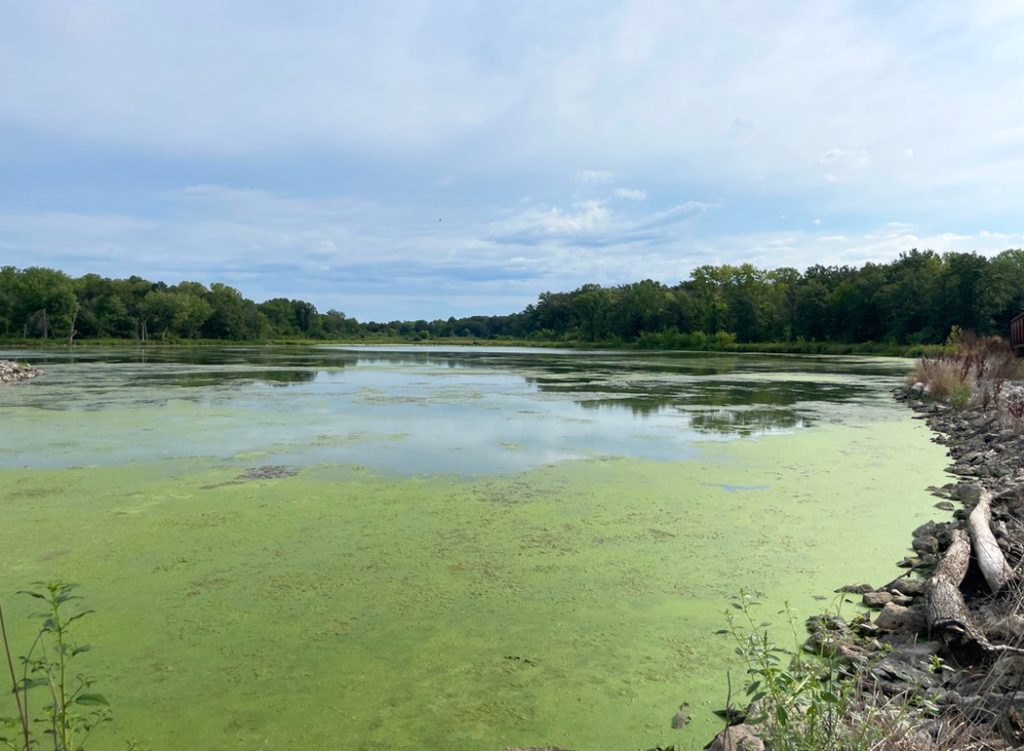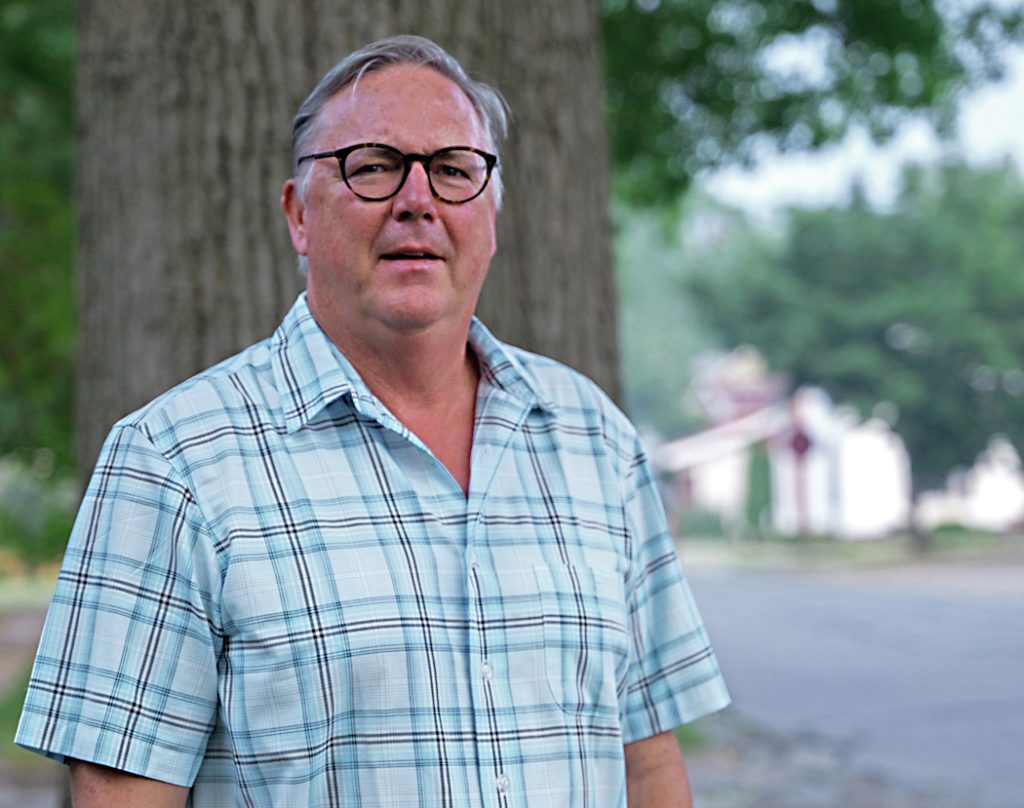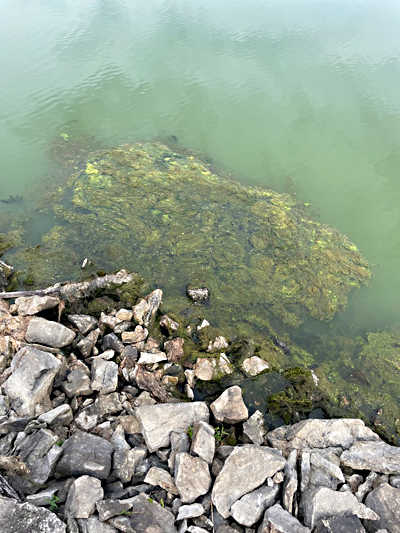
The late summer prairie is in bloom at Lake Darling State Park. Bright yellow swaths of coneflowers are punctuated by small purple explosions of wild bergamot. But Lake Darling, instead of reflecting the blue sky above, is coated in a pale green film of algae that spans the breadth of its southeast arm. A walk over the bridge and along the trail reveals that a creek feeding the lake is an even deeper shade of green. Uphill past the trees and the Lake Darling Youth Center, tidy teal rows of soybeans innocently blanket the land. Backroads stitch vast squares of soy and cornfields to long gravel-white hog barns.

Lake Darling’s status has been “Swimming Not Recommended” since June 21st this year. Lately, the reason is algal toxin levels, which can cause gastrointestinal and respiratory illnesses, rashes, and even liver failure, according to the Iowa Department of Public Health. More often, swimming is “not recommended” due to excess levels of Escherichia coli, or E. coli, another cause of gastrointestinal illness that becomes dangerous if it infects the kidneys.
According to the Iowa Department of Natural Resources water monitoring data, Lake Darling is not an anomaly. Seventeen state beaches had beach advisories as of August 18. Research led by Dr. Chris Jones, recently retired from the University of Iowa’s Hydroscience and Engineering Laboratory, traces the pollution of watersheds from cropland to creeks to rivers and municipal water supplies. Ultimately, agricultural runoff flows down the Mississippi to a dead zone in the gulf of Mexico that averages over 4,000 square miles, about half the size of New Jersey. According to Jones’s research, 29 percent of the nitrogen and 15 percent of the phosphorus in the dead zone originate in Iowa.
Slimy green algae along soft clay beaches and muddy water is familiar to Iowans. But once upon a time, as recently as the 1950s, Iowa had clear lakes and streams. “As a child, I played in the stream during the summer all the time,” Terry Philips recalls. Philips grew up on a farm just outside Stockport, along Cedar Creek. “It couldn’t be clearer. You could see little minnows.”
Philips’s farm childhood was not unusual: his dad’s crop rotations included alfalfa and oats as well as corn and soybeans. The family raised cows for dairy and meat as well as goats, sheep, and hogs. The correlation between this statewide approach to farming and Iowa’s clear water was no coincidence. To understand what happened to Iowa’s lakes and rivers, we have to understand what happened to Iowa’s farms and farmers in the half century between the 1950s and early 2000s.

“Not many people talk about the introduction of soybeans,” Jones says. “When soybeans came in, in the late ’50s, early ’60s, the other crops started going out—the oats, the alfalfa, and the clovers.” Farmers relied on crop rotation, alternating corn with alfalfa and clover. Sweet clover adds 100–120 pounds of nitrogen per acre to the soil, while alfalfa adds 120–140. In contrast, soybeans contribute a mere 15–60 pounds per acre.
The ubiquitous trinity of hogs, soy, and corn gradually displaced the pastured cattle that fed on alfalfa, clover, and small grains. “When the soybeans came in, that changed everything, because you went to all cash crop all the time,” Jones explains. Cattle were moved to feedlots. Pigs proliferated to consume the soy. Instead of crop rotation, farmers relied on chemical nitrate. Unlike the fixed nitrogen produced by alfalfa and clover that attaches to soil, nitrate easily moves with water. A heavy rain can whisk it away through the drainage pipes beneath farm fields that prevent flooding, or cause it to leach into groundwater.
When Philips was a teenager in the 1960s, the average U.S. farm was 215.6 acres. Iowa’s farmland was valued between $200–$300 per acre. It was possible to get into farming, but it was also risky. “When I was in high school, if I wanted to get into farming, I could have got a job in town at the factory, then worked the farm on weekends and rented a small tractor, a 10-foot disc, and borrow stuff from my parents or neighbors, because people wanted to see young people succeed,” Philips said. “The problem was, if the weather was good, you could do well. If in the first two years the weather was bad, you might be in a hole that you never got out of. I could be worth millions now. Or I could have gone bust seven times.” Crop diversity and keeping down debt could mitigate risk but not eliminate it. In contrast, being an employee promised secure and predictable income.
Nevertheless, farming boomed in the 1970s. Secretary of Agriculture Earl Butz infamously extolled farmers to “get big or get out” and to farm “fencerow to fencerow.” Across Iowa, farmers complied. Many took out loans for bigger equipment. Wetlands, treelines, and shallow ravines that once had tall grasses were drained, leveled, and tilled, removing vital buffers that had helped keep topsoil and fertilizer out of streams.
“All these things went together,” Jones said. “The availability of commercial fertilizer, the emergence of soybeans, the concentration of animals, the overall consolidation. It’s hard to disentangle all those things.”
In the 1980s, boom went bust and a third of Iowa farmers lost their land and livelihoods. “The degradation or decline of rural Iowa and the environmental pollution are two sides of the same coin that result from consolidation,” Jones said. “As agriculture has consolidated, we’ve depopulated rural Iowa, causing the decline in many of these towns.”
The federal government attempted to alleviate the damage that had been done by introducing the 1985 Farm Bill, also known as the Food Security Act of 1985 or the Pork Promotion, Research, and Consumer Information Act of 1985. The bill created incentives for commodity crops, including corn and soy, and reduced the risk to farmers by providing disaster relief and insurance for those same select crops. It also incentivized conservation of swamps (wetlands) and sod (grasslands) that farmers had been encouraged to eliminate just a few years before.
But the dual decline of Iowa’s water and rural communities had just begun, and would continue to unravel in the coming decades as Iowa’s remaining farmers committed to what were now low-risk commodities.
“I was shaped by the farm crisis,” Jocelyn Engman told me. Engman grew up on a 100-acre farm at the southern edge of Washington County in the 1980s. The country road she lived on was dotted with the homes of other families with children. “By my childhood, you had to be a decent size farm to survive. By the time I was in high school, you couldn’t ask why. I knew that by the time I was in college, you couldn’t make it on a conventional farm with just 100 acres.” Like so many of her generation, Engman left for a big-city career, with no plans to return home.
The human crisis of the 1980s preceded pivotal changes in pork production and the environmental impacts that followed. The farm Engman grew up on was not so different from the one that Philips did. Her family raised a variety of crops, including alfalfa, and varied livestock. Hogs foraged on pasture and woodland, and sheltered in small huts. “They ran all over the farm,” Engman recalls. Like most hog farmers, her family had sows and raised the pigs from farrow to finish. One of Engman’s jobs was to round up stray piglets that wriggled out of their fence.
Summers were spent at Lake Darling. “It was the place to be,” Engman recalls. “My mom had her inner-tube float. We’d splash around for three or four hours twice a week. We had a grand old time.” The lake was bustling with swimmers, canoes, boats, campers, and fishers. There were showers and concessions. By the 1990s, that had changed.
“I always knew growing up near Lake Darling you don’t want to swim there,” said Bethany Vittetoe Glinsmann. She grew up on her family’s hog farm in Washington County. “The water’s polluted because of the goose poop—that’s always what the narrative was. . . . I don’t remember any conversation about agricultural runoff growing up.”
Vittetoe Glinsmann’s family also raised hogs from farrow to finish, but instead of A-frame huts, the family favored long pig barns for their more numerous swine. Vittetoe Glinsmann recalls getting up early in the morning to help with chores before elementary school. But in high school, that changed.
Vittetoe Glinsmann’s family had been responsible for all stages of the hogs’ lives, and for managing all the expenses of feed and sales of pigs. In the 2000s, they began raising pigs on contract for a neighbor instead. Young pigs came to the new modern hog barn that had fans on each end, walls that could be raised and lowered to regulate air flow and temperature, slats in the floor to catch waste in a lagoon, and a shiny pair of large metal feed bins that fed troughs. The children didn’t have to help with chores anymore, and the paycheck was predictable and virtually guaranteed.
Whereas the Vittetoes contracted with a neighbor, most hog farmers contracted with mega corporations. Concentrated animal feedlot operations (CAFOs) were new to Southeast Iowa in the early 2000s. Engman’s family considered whether to build one or go organic; their farm was one-tenth the size necessary for conventional corn and soy.

Goose poop and agriculture runoff have E. coli in common. “It’s present in the fecal waste of all vertebrates,” Jones says. “When we had bison across the landscape, well, they were excreting their waste, there was E. coli in it. The difference is, our streams were clear then. Sunlight kills E. coli.” Now, sediment loosened by tilling and algae blooms fed by fertilizer make the water turbid. Instead of being killed by sunlight, E. coli colonizes the organic matter in dark lakes and streams.
“We have 25 million hogs,” Jones says. “The landscape has been saturated. Every time it rains, the E. coli level in our streams goes through the roof.”
Concentrated liquid hog waste is applied to farm fields within a few-mile radius; it’s not cost effective to move it far from its source. The nitrogen- and phosphorus-rich manure is valuable fertilizer for crops, but it devastates aquatic ecosystems with algae blooms that deplete oxygen in the water and create dead zones. Jones describes some manure spreading practices as “indefensible,” and that includes “cropping up to stream banks and putting manure on snow.”
Consolidated pork production has faced increasing bipartisan criticism since the purchase of Smithfield Food, the largest global pork producer, by the Chinese company Shuanghui Group in 2013. “Money is not staying here,” Jones says. “The meat is going elsewhere, too. This is just another example of globalization. The revenue goes into the hands of very few people, many of them probably not even living here in Iowa, but the pollution stays here.”
Engman resents American flags being flown beside industrial hog barns. To her, the concentrated feedlots shrouded in stench are a symbol of rural decline. “It’s polluting everything around it and emptying out all the people on the land around it,” she says.
Since returning to Iowa more than 15 years ago, Engman has observed the steady erosion of farmers from the land. “One by one, people moved out of the houses. The houses go to disarray, then they burn down, including my own house.” Only two neighbors still live on their farms. “One farm family really embraces the big conventional farm, the very modern place down the road,” she tells me. Then there’s Tom. “Tom has been there forever. He’s still there, but he threatens to move a lot.”
Many young farmers and would-be farmers want a way out of the corn-soy-hog trinity cemented into Iowa’s landscape by the 1985 Farm Bill that was meant to solve the problems of their parents’ generation. But banks and federal programs do little to support alternatives.
Jones thinks that system is past due for a change. “We need to design our agricultural systems from the perspective of human nutrition and environmental outcomes,” he told me. “We need to create different decision frameworks all up and down the value chain, not just on the backs of farmers.”
The minimum viable size for a modern farm is 1,000 acres, with many reaching 5,000–10,000 acres. Today, farmland prices average over $11,000 per acre. In spite of John Deere’s mechanical ingenuity, which enables farmers to complete both planting and harvests in about eight weeks a year, farming is a financially formidable business to get into. Banks prefer the low risk of government-insured, which is to say taxpayer-insured, crops.
Engman likens intergenerational commodity farming and pig contracts to “inheriting a franchise.” She notes, “It’s already built in if you follow it, with a guaranteed customer base. Whereas a business has no guarantees and all kinds of risks. You have to be creative. You have to do everything.”
Engman’s formative experiences of the farm crisis as a child make her leery of big bank loans and federal crop guarantees subject to policy change. She and her husband, Tim, chose to assume the risks of being small business owners instead and set out to “zombie proof” their small farm. After years of trial, error, and adaptation, they now grow and process herbs for a line of shelf-stable culinary and bath products.
Vittetoe Glinsmann’s brother wants to diversify the family’s farm. When some of the land retired from a conservation reserve program, he bought a small herd of belted Galloway cattle and started grazing them. Next, he added a flock of laying chickens. But soy, corn, and contract pigs are still foundational.
“Being entrenched in the system is still really hard to break out of,” Vittetoe Glinsmann says. “Farmers say that they don’t want government handouts, and they want free markets. So why can’t we remove some of these subsidies and make it a level playing field for folks who want to diversify?”
Jones argues that nutrient standards for streams would help to level the playing field by holding large corporations, including international companies like Shuanghui Group, accountable for the costs of pollution currently footed by Iowa’s taxpayers.
“We give agriculture a pass here, because we don’t make them legally and fiscally responsible for the pollution. To my knowledge, there’s no other industry that we give that pass to,” Jones says. “If you want to raise corn and hippopotamuses, we don’t care, as long as you’re meeting the water-quality standard.”
To Jones, revitalizing rural communities and clean water are inextricably tied. He believes regulating water quality will necessitate a return to crop diversity and increase the number of farmers.
In 2008, Lake Darling was drained to replace the leaky dam, remove silt, and address pollution problems that had nothing to do with geese. Twelve million dollars was invested in the lake and its watershed, including 162 projects on private land upstream. According to Iowa Department of Natural Resources biologist Vance Polton, 59 local land owners worked “to solve erosion and nutrient loss problems on their own ground, which is 89 percent of the watershed.”
In 2014, Lake Darling reopened. “What people often don’t understand is that to clean up the water, you must first address the land,” park ranger Zachary Haworth told a reporter in spring of 2016 when the lake’s water was still clean. Visitors flocked to swim, boat, and fish, just as they had from the lake’s dedication in 1950 through the1980s. The triumph was short lived. Nitrogen, phosphorus, silt, and solids kept finding their way downhill and downstream, from cropland to lakes and streams, and from Iowa to the Gulf of Mexico.
“If anything’s going to change, people who live in urban areas are going to have to know and care,” Engman says. “It’s not going to be the rural people. We’re dying out. We’re moving out. We’re gone.” As a farmer, Engman believes water quality is a problem for all Iowans, and that clean water is a fundamental right.
Jones agrees. “People need to agitate with their local leaders, like county supervisors and city councils, and so forth, for clean water. Let’s face it, the system we have here is entrenched, right? It’s not just going to magically disappear.”
